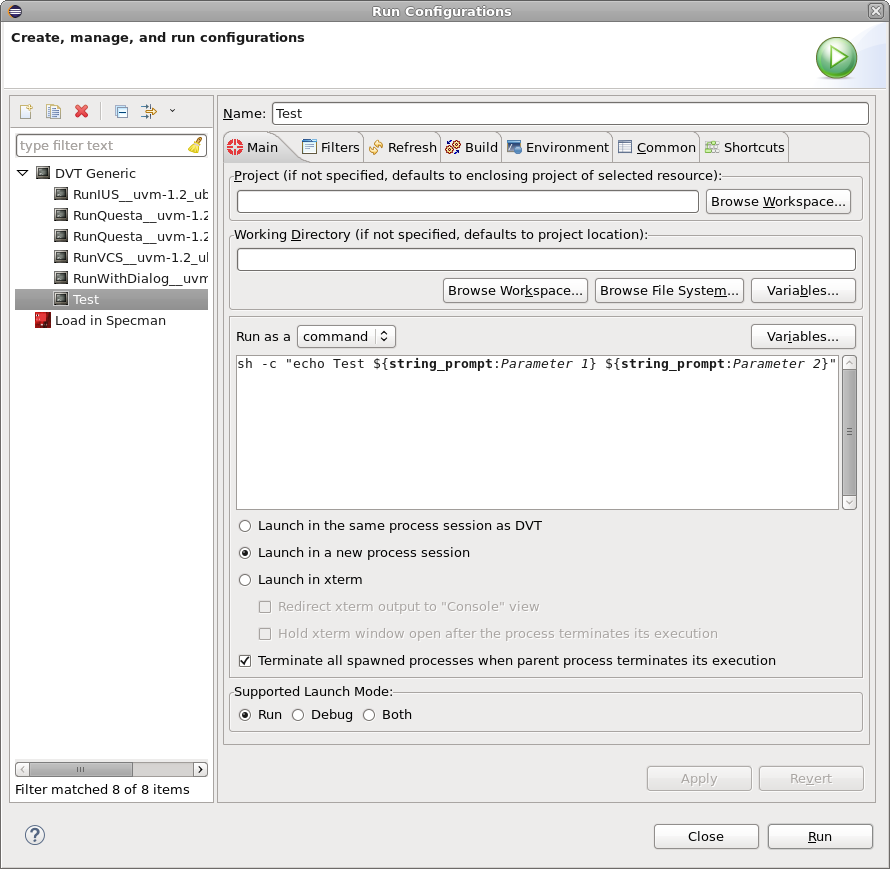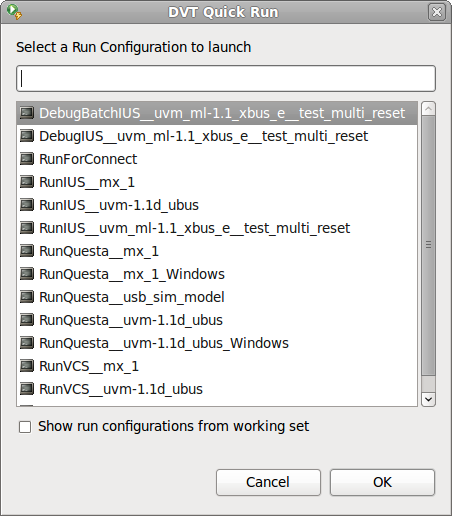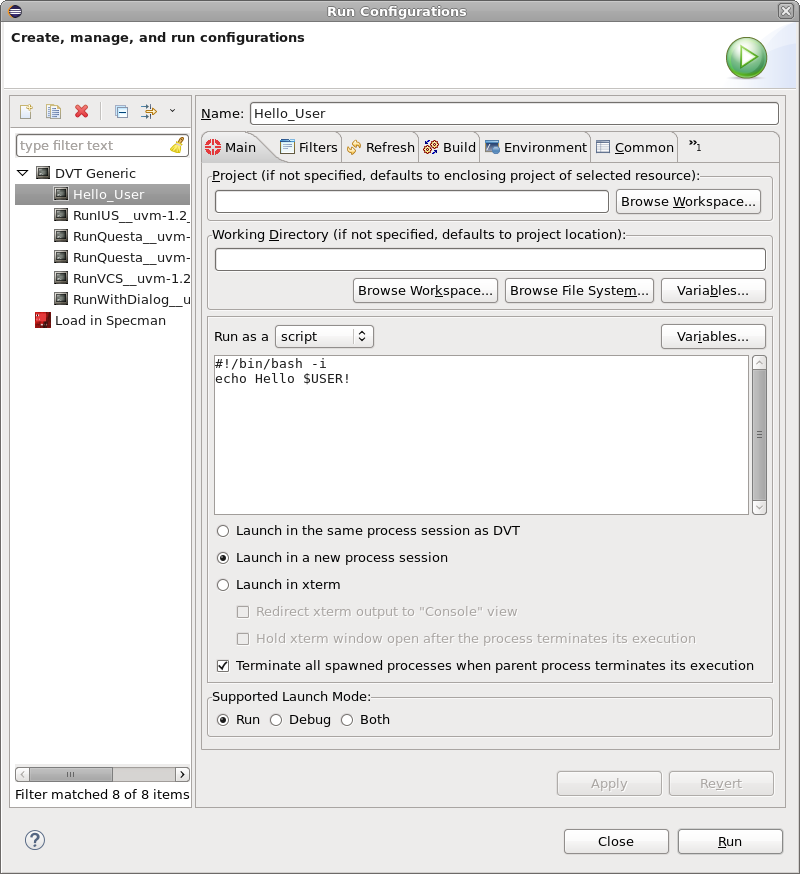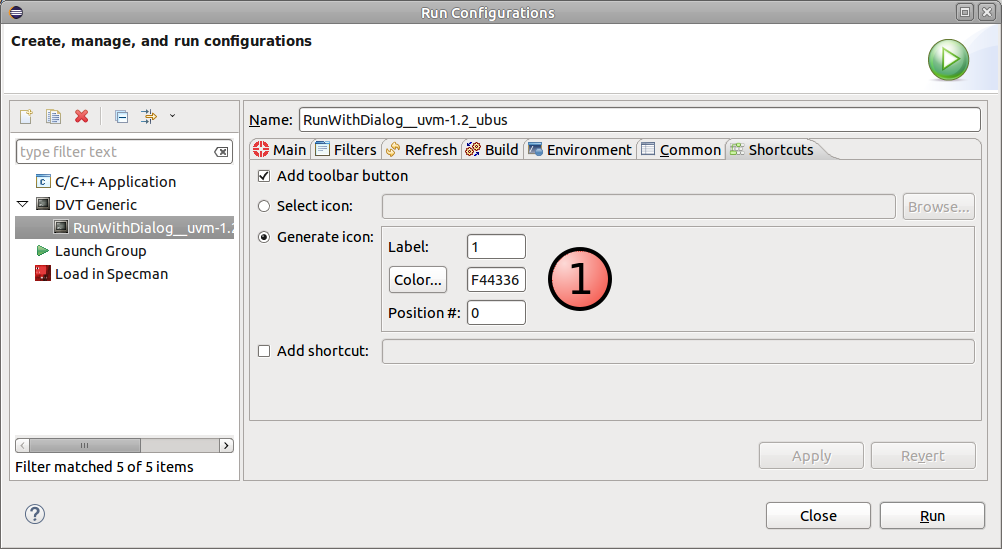Run Configurations
You can invoke (run) any executable from Eclipse and see its output in the Console View.
You just need to create a Run Configuration from menu Run > Run….
VlogDT provides one type of configuration:
DVT Generic
DVT Generic Run Configuration
Menu Run > Run Configurations….
Select DVT Generic configuration and click the New button.
Specify name, working directory, run as command or script and the content of the command or script.
Click Run.

Before writing the command you can specify how to run the content. Run as a:
command: the content must be a single line command with arguments
script: the content must be a multiline script, preceded by a hash exclam; in Windows the script will run using cmd.exe, if a #!/bin/sh hash exclam exists on the first line the script will be executed using Busybox included in the distribution
If run as a command is selected the content should look like this:
sh -c "echo Test ${string_prompt:Parameter 1} ${string_prompt:Parameter 2}"
or if run as a script is selected a script with hash exclam must be specified:
#!/bin/sh
echo Test ${string_prompt:Parameter 1} ${string_prompt:Parameter 2}
for i in `seq 5 -1 0` ; do
echo Starting in $i seconds
sleep 1
done
echo Test started
Parameters can be specified using Eclipse variables or DVT Custom Dialogs can be used for more complex dialogs.
As a result you will be asked to provide the “Parameter 1” e.g. “run” and “Parameter 2” e.g. “script”. The result of running the command will be:
“Test run script”
Note
The parameters ${VAR} are considered Eclipse variables that and will be resolved before running the command. To use shell variables in the command you must use the $VAR syntax.
When running as a command, unresolved Eclipse variables will trigger an error and the run will be aborted. not be reported. When running as a script the unresolved Eclipse variables will remain untouched.
Supported Launch Modes
You may choose if a launch configuration can be launched in Run mode, Debug mode or both.
When both modes are supported, launching from a Custom Shortcut and Button for a Run Configuration will prompt for launch mode.
See Debugger Integration for more details on debugging your code in DVT.
Quick Run
You can launch again at any time from menu Run > Run History… or directly from the toolbar (simple click launches last):

You can also use the Run > Quick Run menu (or Ctrl+U shortcut key) to quickly launch any existing Run Configuration:

The DVT Quick Run dialog will pop-up and present a list of all available Run Configurations. You can use the quick filter to search for a specific Run Configuration, up and down arrows to navigate in the list and Enter to launch:

Output
The invocation output is dumped to the Console View.
Click on hyperlinks in the Console View to jump directly to the to source location.

Run Configuration Session Type
Note
The options available under the command/script text box can be used to control the process session that will be used to run the command or script. The following session types are available:
Same process session as DVT
The process will be a direct child of DVT
The process must manage its subprocesses if termination signals are received, otherwise orphaned processes may appear
Job control is not available
stdin, stdout, stderr will be available in “Console View”, tty will not be available
A new process session
The process will be launched using a wrapper script that will create a new process session
The process may manage its subprocesses if termination signals are received, but “Terminate all spawned processes…” option can be used to kill all subprocesses when the parent process ends or is terminated
Job control is available
stdin, stdout, stderr will be available in “Console View”, tty will not be available
An xterm process session (xterm must be available in the system)
The process will be launched using xterm that will create a new process session
The process may manage its subprocesses if termination signals are received, but “Terminate all spawned processes…” option can be used to kill all subprocesses when the parent process ends or is terminated
Job control is available
tty, stdin, stdout and stderr will be available in xterm, the stdout, stderr can be redirected to “Console View” using “Redirect xterm output…” option
xterm window can remain on screen when the process ends or is terminated if “Hold xterm window open…” option is selected

Using environment variables in DVT Generic Run Configurations
Environment variables can be set in the following ways:
in the shell where DVT was launched
using the +dvt_setenv+ directive in the project’s build configuration file (.dvt/default.build) - see Environment Variables
from the Environment tab of the Run Configurations dialog (menu Run > Run Configurations)
directly within the command getting executed, for example: sh -c “env PROJECT_DIR=${project_loc} iev -f ${project_loc}/iev/iev.f -c”.
To ensure that an environment variable ENV_VAR is expanded correctly, use the simple $ENV_VAR notation.
Use the enclosing curly brackets ${ENV_VAR} notation only for Eclipse specific variables. You can find a list of these DVT Generic Run Configuration Variables.
Using an alias in a DVT Generic Run Configuration
Aliases only work in interactive shells. The command specified in the Run Configuration should be:
<your_shell> -ic “<your_alias>”
for example
bash -ic “ll”
When you create a new DVT Generic Run Configuration, DVT tries to guess the shell that you use from the $SHELL system variable and fills it in for you.
DVT Generic Run Configuration Variables
The following variables are available when you configure a run configuration. These variables are automatically expanded each time the run configuration is launched.
DVT variables
Name |
Description |
|---|---|
${selected_resources_loc} |
Absolute file system path of the selected resources separated by system file separator character. You can pass as argument a string to be used as separator. |
${selected_resources_path} |
Workspace relative path of the selected resources separated by system file separator character. You can pass as argument a string to be used as separator. |
${selected_resources_name} |
The name of the selected resources separated by system file separator character. You can pass as argument a string to be used as separator. |
${selected_resource_line} |
The line of the cursor from the selected resource. |
${dvt_current_build_file} |
Absolute path to the current DVT build file |
${dvt_cli} |
Expands to the full DVT CLI path, using as the workspace option the current workspace: $DVT_HOME/bin/dvt_cli.sh -workspace ${workspace_loc} |
${dvt_sim_compile_file_list} |
List of files compiled by DVT, in compilation dependency order, including library and compile syntax information (VHDL only). Each line in the variable expansion has the format: <library> <langauage_syntax> <file_full_path>. If a file path is provided as an argument to this variable, all the files required for the compilation of the provided file are listed (including itself). If in addition “comp_deps” is provided as first argument, the entities instantiated through components will also be considered a compilation dependency |
Eclipse variables
Name |
Description |
${workspace_loc} |
The absolute path on the system’s hard drive to Eclipse’s workspace directory |
${workspace_loc:<resource path>} |
The absolute path on the system’s hard drive to the specified resource. The <resource path> is the full path of the resource relative to the workspace root. For example ${workspace_loc:/MyProject/MyFile.txt}. Note that the expanded result of this variable is not the same as ${workspace_loc}/MyProject/MyFile.txt if the project’s contents directory for MyProject is outside the workspace directory. |
${project_loc} |
The absolute path on the system’s hard drive to the currently selected resource’s project or to the project being built if the external tool is run as part of a build. |
${project_loc:<resource path>} |
The absolute path on the system’s hard drive to the specified resource’s project. The <resource path> is the full path of the resource relative to the workspace root. For example ${workspace_loc:/MyProject/MyFile.txt}. Note that the expanded result of this variable is not the same as ${workspace_loc}/MyProject if the project’s contents directory for MyProject is outside the workspace directory. |
${container_loc} |
The absolute path on the system’s hard drive to the currently selected resource’s parent (either a folder or project). |
${container_loc:<resource path>} |
The absolute path on the system’s hard drive to the specified resource’s parent (either a folder or project). The <resource path> is the full path of the resource relative to the workspace root. For example:${workspace_loc:/MyProject/MyFolder/MyFile.txt}. Note that the expanded result of this variable is not the same as ${workspace_loc}/MyProject/MyFolder if the project’s contents directory for MyProject is outside the workspace directory. |
${resource_loc} |
The absolute path on the system’s hard drive to the currently selected resource. |
${resource_loc:<resource path>} |
The absolute path on the system’s hard drive to the specified resource. The <resource path> is the full path of the resource relative to the workspace root. For example ${workspace_loc:/MyProject/MyFile.txt}. Note that the expanded result of this variable is not the same as ${workspace_loc}/MyProject/MyFile.txt if the project’s contents directory for MyProject is outside the workspace directory. |
${project_path} |
The full path, relative to the workspace root, of the currently selected resource’s project or of the project being built if the external tool is run as part of a build. |
${container_path} |
The full path, relative to the workspace root, of the currently selected resource’s parent (either a folder or project). |
${resource_path} |
The full path, relative to the workspace root, of the currently selected resource. |
${project_name} |
The name of the currently selected resource’s project or of the project being built if the external tool is run as part of a build. |
${container_name} |
The name of the currently selected resource’s parent (either a folder or project). |
${resource_name} |
The name of the currently selected resource. |

